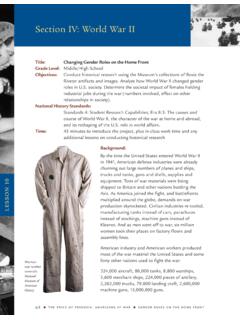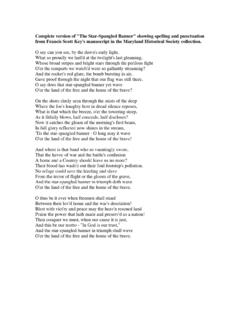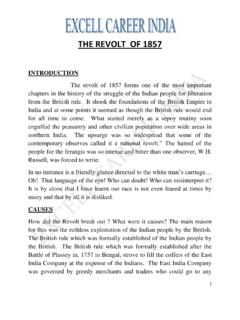Transcription of Section I: War of Independence
1 Title: Who s in Camp?Grade Level:Elementary SchoolObjectives: Understand who fought the War of Independence and how their livesand the lives of their families were affected by the History Standards:Standard 2: Student comprehends historical sources; Standard 5:Student engages in historical issues analysis and decision-making; Era3: Revolution and the new nation (1754 1820s), Standard 1C: Compareand explain the people s different roles and perspectives in the : 45 minutesBackground: In June of 1775, the Continental Congress united the troops of the several coloniesinto a single Continental army for the Defense of American Liberty under thecommand of General George Washington. The men of Washington s army were youngand mostly poor farmers, f ishermen, and artisans; some were Africans. All werevolunteers (although many joined for a cash award). They gathered in camps, joinedby local militia units and civilians in every imaginable capacity. Soldiers rose early each day and went to bed early each night: Washington ordered that all lights must be put out at 9 o clock in the evening, and every man to his tent.
2 Eachday they drilled in the manual exercise, the precise sequence of steps involved inloading and f iring their muskets. They marched and maneuvered in long linearformations, learning to move and f ight as one. Each day, they were supposed to receiverations and supplies: a pound of beef or pork, peas and beans, a pound of flour, a quartof cider, milk, a half-cup of rum; every week they were supposed to receive a pound ofsalted f ish, two cups of vinegar (to prevent scurvy), candles, soap, fresh straw for theirbeds. But rations were often spoiled and supplies inadequate; many foraged for food inlocal f ields and orchards. Thousands malnourished and exhausted died when diseaseslike putrid diarrhea ravaged the camps. In fact, more soldiers died from disease thanwere killed by musket f ire, rolling and bouncing cannonballs, or bayonet price of freedom: americans at warwho s in camp? Section I: War of IndependenceLESSON 2 The best Patriot [will be the one] who contributes mostto this glorious work, whatever his Station or fromwhatever part of the Continent he may come.
3 George Washington, 1776 Who played with toys?Hint:They received a half-ration of wore their own hats?Hint:They were not part of the regular used lots of lye soap? Hint:They did piles of kept bloodsucking leeches in a jar?Hint:They used them to treat carried a camp pot?Hint:They ate carried a spontoon?Hint:They told recruits to mind the music and the step. Who s in Camp?Who s in Camp?Who s in Camp?Who s in Camp?Who s in Camp?Who s in Camp?Childrenlived in camp with their fathersand mothers. Although they were anaccepted presence in camp, GeorgeWashington once complained that themultitude of women in particular, especiallythose who are pregnant, or have children,are a clog upon every movement. Militiamenwere citizen soldiers who woreregular clothes and carried their ownequipment. They were local white men,and sometimes free black men, betweenthe ages of sixteen and sixty. They werecalled out only as needed, elected theirown off icers, and decided where and whento f usually the wives or relatives ofsoldiers followed the army wherever itwent.
4 Most washed and mended clothes;some cooked or took care of the sick that many illnesses werecaused by an imbalance in the body sfluids, known as humors. They usedleeches to remove excess blood in aneffort to restore the balance of bodilyfluids. In reality, bleeding resulted inlowered blood pressure, dehydration,infection and often the army were divided intogroups of six to eight men, called a group was issued a camp pot and didits own cooking. They carried the heavyiron pot wherever they went. Because themeat they received as rations was often ofpoor quality even infested with maggots they had to boil spontoons, pole arms thatsignaled their rank. Each day they drilled theirmen in the sequence of steps involved inloading and f iring their muskets. Theypracticed their troops in marching andmaneuvering in long, shoulder-to-shoulderlines. Because off icers carried no f irearms, the spontoon s sharpened iron blade wastheir only s in Camp?Who s in Camp?Who s in Camp?
5 Who s in Camp?Who s in Camp?Who s in Camp?Image courtesy of National Library of MedicineMaterials:Six sets of the six object cardsThe Fighting Groundby AviThe American Revolution: A History in Their Own Wordsby Milton MeltzerThe Way of Duty: A Woman and Her Family in Revolutionary Americaby R. BuelBlack Heroes of the American Revolutionby Burke DavisIf You Were There in 1776by Barbara BrennerThe Minute Men: The First Fight-Myths and Realities of the AmericanRevolutionby John GalvinLesson:As pre-lesson homework, have students read one of the six books about life during theWar of Independence . In class, divide the students into six groups and give each group a set of object them analyze the object on the image side of the card and write answers to thefollowing questions: Can you identify this object? What is its function? Who mighthave needed such an object in a soldiers encampment? Have them assign a type ofperson who might have used the artifact for each object they have.
6 Then ask thestudents to turn the cards over to learn the identity of the person. Finally, ask each student to choose one of the six people. In the voice of the character,have students write a letter home about their experiences during the war. This willallow them to use their research from the reading assignment and their investigationof the object s in camp? the price of freedom: americans at war 13 Artist s rendering of Continental army camp on Long Island, July 1776 GeneralDaso, Dik, ed., with Howard Morrison and David Allison. The Price of Freedom: Americans at Books, I: War of IndependenceBrenner, Barbara. If You Were There in Press, , John R. The Minute Men: The First Fight Myths and Realities of the American Books, , Albert. George Washington and the Founding of a Children s Books, , Milton. The American Revolutionaries: A History in Their Own Words 1750 , , Arthur B. Lexington and Concord: The Beginning of the War of the American Revolution. W. W.
7 Norton, , Nancy. The Shot Heard Round the World: The Battles of Lexington & Concord. Morgan Reynolds, II: Wars of ExpansionBachrach, Deborah. Custer s Last Stand: Opposing Press, , Carol and Thomas. The Books, , Angela M. Beyond the Mississippi: Early Westward Expansion of the United , , Albert. Tatan ka Iyota ke: Sitting Bull & His World. Dutton Chidren s Books, III: Civil WarBetter, Susan Provost. Billy Yank and Johnny Reb: Soldiering in the Civil War. Twenty-First Century, , Ina. A Separate Battle: Women & the Civil War. Lodestar Books, , Brown: One Man Against , , James M. Fields of Fury: The American Civil War. Simon & Schuster/Atheneum, Milton. Voices from the Civil War: A Documentary History of the Great American Conflict. HarperCollins, , Jim. The Boy s War. Confederates & Union Soldiers Talk about the Civil Books, , Catherine. Civil War Soldiers: African-American Century, IV: World War IIBachle, Rosemary Eckroat. Women s War Heritage Books, 1999.
8 DeLee, Nigel. Voices from the Battle of the Bulge. David and Charles, , Sherna Berger. Rosie the Riveter Revisited: Women, the War, and Social , 1987. Green, Gladys and Michael. Patton and the Battle of the International, , Judith Pinkerton. Growing Up in World War II 1941 Publications, , Tim. Battle of the House, V: Cold War/VietnamBlight, James G., and David Intelligence and the Cuban Missile Cass, , Dino A. Eyeball to Eyeball: The Inside Story of the Cuban Missile Crisis. Random House, , Bernard. Dear America: Letters Home from Vietnam. W. W. Norton, , Svetlana, and Sarah Wallis. Intimate Voices from the First World War. William Morrow, VI: September 11 and Its AftermathDudley, William, ed. The Attack on America: September 11, , , Mitch. Understanding September , , Anne, ed. With Their Eyes: September 11th the View from a High School at Ground , price of freedom: americans at warbibliographyBibliographyAmericans at War,produced by The History Channel An introduction to the themes of the exhibitionWar of IndependenceFirst-Person Accounts, produced by Pyramid Studios:Lydia Minturn Post, Long Island housewife, 1776 James Collins, teenage soldier, no dateDoonyontat, Wyandot chief, 1779 Elijah Churchill, recipient of the f irst Purple Heart, 1783 Mexican WarFirst-Person Accounts, produced by Pyramid Studios:Jos Mar a Tornel y Mend vil, Mexican secretary of war, 1837 George Ballentine, English volunteer for the United States, 1853 Juan Bautista Vigil y Alarid, acting governor of New Mexico, 1846 Ulysses S.
9 Grant, American soldier, 1885 Civil WarFirst-Person Accounts, produced by Pyramid Studios:Louis Myers, Third West Virginia Infantry, 1862 William G. Christie, Minnesota soldier, 1863 Eugenia Phillips, spy for the South in Washington , 1861 Spottswood Rice, African American Union soldier, 1864 World War IWorld War I Overview, produced by The History ChannelWorld War IIWorld War II Cartoons, produced by The History ChannelWorld War II Overviews in the Newsreel format, produced by The History ChannelFrom World War I to World War IIThe North Atlantic and North African Theater The European Theater The Pacif ic TheaterThe USO in World War II, produced by The History ChannelFirst-Person Accounts, produced by Pyramid Studios:George Hynes, Army, a last letter home, 1942 Robert Morris, Coast Guard, f ighting in Italy, 1943 Robert Sherrod, journalist, the beach at Tarawa, 1943 Ann Darr, Women Airforce Service Pilots, 1997 Daniel Inouye, Medal of Honor recipient, 2000 VietnamExcerpt from Huey Helicopter Air Armada, The History Channel documentary, 2002 First-Person Accounts, produced by Arrowhead Film & Video.
10 Hal Moore, commander of a Seventh Cavalry Regiment battalion, 2003 Fred Castleberry, veteran of the Twenty-f ifth Infantry Division, 2002 Clarence Sasser, recipient of the Medal of Honor, 2004,(produced by Pyramid Studios)The Price of Freedom: Americans at War Teacher s Manual DVD MenuDepartment of Education and Public ProgramsNational Museum of American HistorySmithsonian Institution, MRC 603 Washington 20013-7012

















